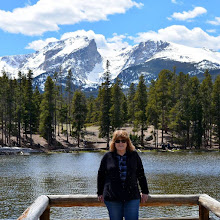Well, truth be told, the bear was not exactly in my backyard, but it was very close!
As you may know, if you regularly read my blog, my husband and I moved from New York City to the greater Denver area this past winter, and we bought a home in a community very close to the foothills of the Rocky Mountains. It's a beautiful area, full of public and "resident only" nature trails. In fact, we share this neighborhood with many wild animals that reside in the foothills; I have seen mule deer, coyote, and red fox pass through my backyard. They usually pass by quickly, on their way towards open land, and I don't feel threatened by them at all. Seeing a bear in my yard, however, would be another matter, entirely!
We get weekly warnings every garbage collection day in our community to put out our garbage cans at the last possible moment and to remove bird feeders and keep our garage doors closed. In fact, our community has a web page with the same title as this post, telling us what to do if we do see a bear in our yard! I never thought I'd really see an actual bear, however, unless I was on a trail in the foothills. I was mistaken!
Very close to our house is a paved, resident only, trail that loops around the open space in the center of many resident subdivisions. It's a wonderfully scenic walk and I like that it has some hills along the way that make it a challenge, for me, to walk.
As soon as my husband and I entered the trail one early evening, we were met with this very excited group of bicycle riders who told us they heard a bear was spotted in a tree along the trail! I was happy I had my camera along for the walk.
Just a few yards down the path we saw it! Look closely toward the middle right of the tree--do you see it? I admit I would never have noticed this bear if I hadn't been told about it.
A closer look, taken with my zoom lens!
Not only was there one bear in this tree--there were three!
It was a sow and her two cubs! Seeing this made me more nervous, as a mother bear will become more aggressive if she feels her cubs are threatened. They were all sound asleep, however, and oblivious to the people they were attracting on the ground--for now!
Bears are active in our area in the spring and autumn seasons as they are looking for water and food--an average black bear needs to consume 20,000 calories a day! According to another community web page called "Living With Bears":
"Black bears eat almost anything. They will eat human food, garbage, hummingbird food, and pet and livestock food when available. Once a bear has found the easily accessible, consistent food source that human settlements can offer, it may overcome its wariness of people and visit regularly, increasing the chance of a human/bear encounter. You and your neighbors can make a difference. Your actions may prevent the unnecessary death of a bear!"
We feel fortunate to co-exist among wonderful wildlife, but one thing for sure-- from now on I'll be looking up into the trees whenever I walk on a trail!




































































